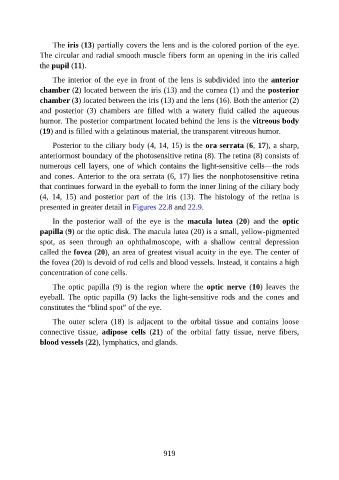Page 920 - Atlas of Histology with Functional Correlations
P. 920
The iris (13) partially covers the lens and is the colored portion of the eye.
The circular and radial smooth muscle fibers form an opening in the iris called
the pupil (11).
The interior of the eye in front of the lens is subdivided into the anterior
chamber (2) located between the iris (13) and the cornea (1) and the posterior
chamber (3) located between the iris (13) and the lens (16). Both the anterior (2)
and posterior (3) chambers are filled with a watery fluid called the aqueous
humor. The posterior compartment located behind the lens is the vitreous body
(19) and is filled with a gelatinous material, the transparent vitreous humor.
Posterior to the ciliary body (4, 14, 15) is the ora serrata (6, 17), a sharp,
anteriormost boundary of the photosensitive retina (8). The retina (8) consists of
numerous cell layers, one of which contains the light-sensitive cells—the rods
and cones. Anterior to the ora serrata (6, 17) lies the nonphotosensitive retina
that continues forward in the eyeball to form the inner lining of the ciliary body
(4, 14, 15) and posterior part of the iris (13). The histology of the retina is
presented in greater detail in Figures 22.8 and 22.9.
In the posterior wall of the eye is the macula lutea (20) and the optic
papilla (9) or the optic disk. The macula lutea (20) is a small, yellow-pigmented
spot, as seen through an ophthalmoscope, with a shallow central depression
called the fovea (20), an area of greatest visual acuity in the eye. The center of
the fovea (20) is devoid of rod cells and blood vessels. Instead, it contains a high
concentration of cone cells.
The optic papilla (9) is the region where the optic nerve (10) leaves the
eyeball. The optic papilla (9) lacks the light-sensitive rods and the cones and
constitutes the “blind spot” of the eye.
The outer sclera (18) is adjacent to the orbital tissue and contains loose
connective tissue, adipose cells (21) of the orbital fatty tissue, nerve fibers,
blood vessels (22), lymphatics, and glands.
919

